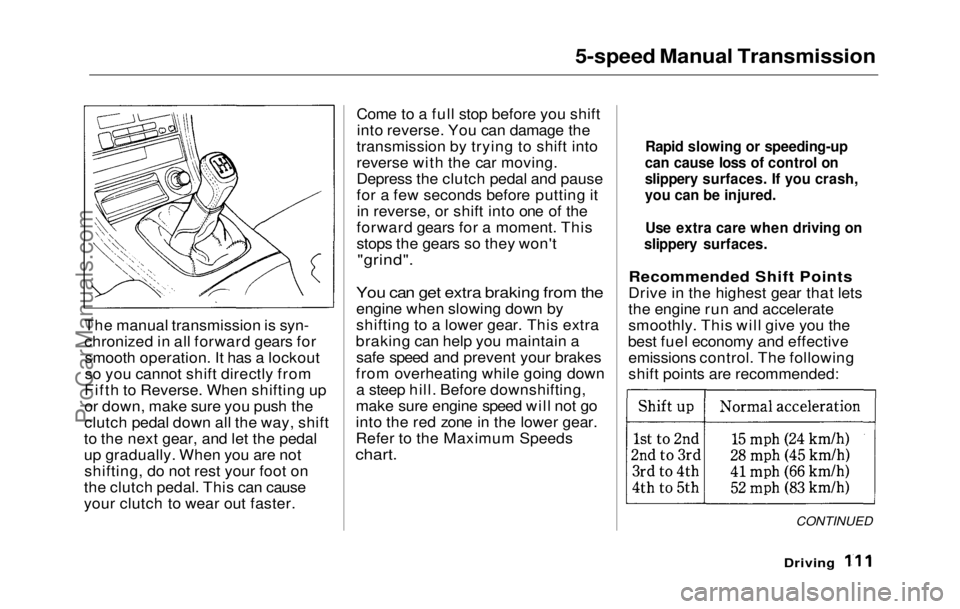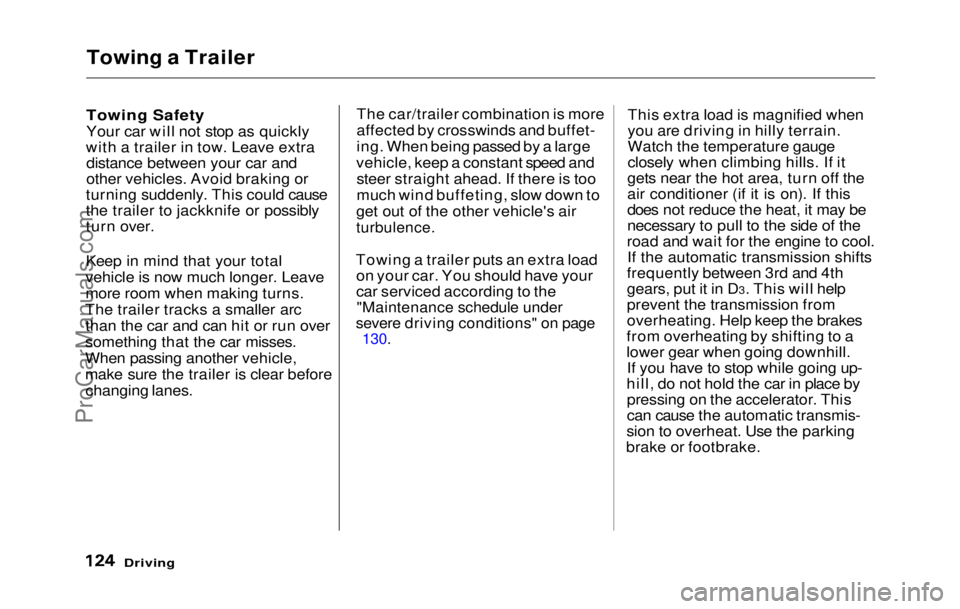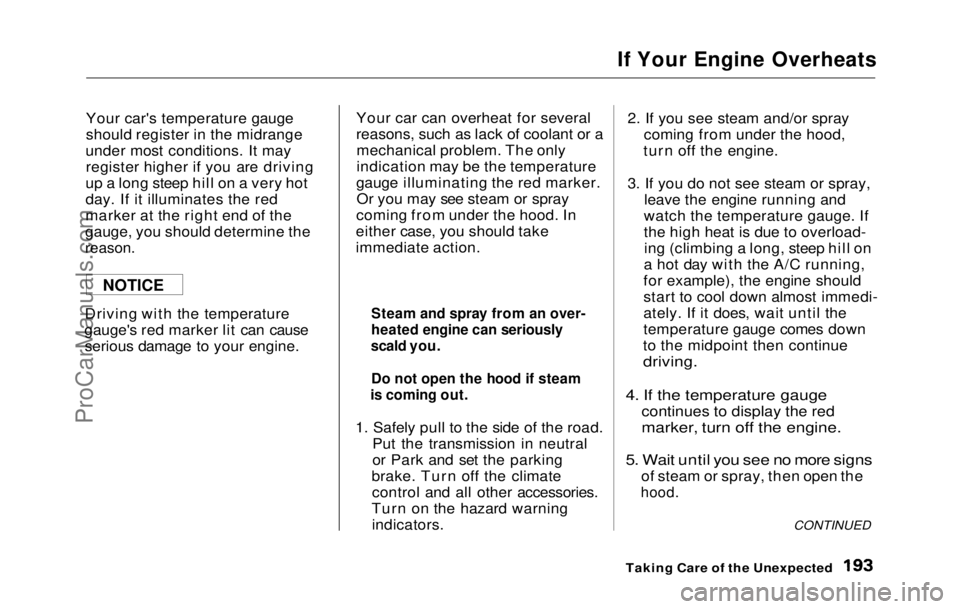1992 HONDA PRELUDE engine overheat
[x] Cancel search: engine overheatPage 110 of 225

5-speed Manual Transmission
The manual
transmission is syn-
chronized in all forward gears for smooth operation. It has a lockout
so you cannot shift directly from
Fifth to Reverse. When shifting up
or down, make sure you push the
clutch pedal down all the way, shift
to the next gear, and let the pedal
up gradually. When you are not shifting, do not rest your foot on
the clutch pedal. This can cause
your clutch to wear out faster. Come to a full stop before you shift
into reverse. You can damage the
transmission by trying to shift into
reverse with the car moving.
Depress the clutch pedal and pause
for a few seconds before putting it in reverse, or shift into one of the
forward gears for a moment. This
stops the gears so they won't
"grind".
You can get extra braking from the
engine when slowing down by
shifting to a lower gear. This extra
braking can help you maintain a safe speed and prevent your brakes
from overheating while going down a steep hill. Before downshifting,
make sure engine speed will not go
into the red zone in the lower gear.
Refer to the Maximum Speeds
chart.
Recommended Shift Points
Drive in the highest gear that lets
the engine run and accelerate
smoothly. This will give you the
best fuel economy and effective emissions control. The following
shift points are recommended:
CONTINUED
Driving
Rapid slowing or speeding-up
can cause loss of control on
slippery surfaces. If you crash,
you can be injured.
Use extra care when driving on
slippery surfaces.ProCarManuals.comMain Menu Table of Contents s t
Page 123 of 225

Towing a Trailer
Towing Safety
Your car will not stop as quickly
with a trailer in tow. Leave extra distance between your car and
other vehicles. Avoid braking or
turning suddenly. This could cause
the trailer to jackknife or possibly
turn over.
Keep in mind that your total
vehicle is now much longer. Leave
more room when making turns.
The trailer tracks a smaller arc than the car and can hit or run over
something that the car misses.
When passing another vehicle,
make sure the trailer is clear before changing lanes. The car/trailer combination is more
affected by crosswinds and buffet-
ing. When being passed by a large
vehicle, keep a constant speed and steer straight ahead. If there is too
much wind buffeting, slow down to
get out of the other vehicle's air
turbulence.
Towing a trailer puts an extra load on your car. You should have your
car serviced according to the
"Maintenance schedule under
severe driving conditions" on page
130.
This extra load is magnified when
you are driving in hilly terrain.
Watch the temperature gauge
closely when climbing hills. If it
gets near the hot area, turn off the
air conditioner (if it is on). If this
does not reduce the heat, it may be
necessary to pull to the side of the
road and wait for the engine to cool. If the automatic transmission shifts
frequently between 3rd and 4th
gears, put it in D3. This will help
prevent the transmission from
overheating. Help keep the brakes
from overheating by shifting to a
lower gear when going downhill. If you have to stop while going up-
hill, do not hold the car in place by pressing on the accelerator. This
can cause the automatic transmis-
sion to overheat. Use the parking
brake or footbrake.
DrivingProCarManuals.comMain Menu Table of Contents s t
Page 149 of 225

Spark Plugs
4. Set the gap on the new spark plug with a wire-type spark plug
gapping tool. Do not use a blade-
type feeler gauge. Plug gap should be: 1.1 mm (0.04 in)
5. Put the new spark plug into the socket, then thread it into the
hole. Screw it in by hand so you do not crossthread it.
6. Torque the spark plug. (If you do
not have a torque wrench, tight-
en the spark plug one-quarter
turn after it contacts the cylinder
head.)
Tightening torque:
18 N .
m(1.8 kg-m, 13 Ib-ft)
Tighten the spark plugs carefully.
A spark plug that is too loose can overheat and damage the engine.
Overtightening can cause damage
to the threads in the cylinder head.
7. Install the spark plug cap.
8. Repeat this procedure for the other three spark plugs.
CONTINUED
Maintenance
NOTICEProCarManuals.comMain Menu Table of Contents s t
Page 179 of 225

Taking Care of the Unexpected
This section covers the more- common problems that motorists
experience with their cars. It gives
you information about how to
safely evaluate the problem and
what to do to correct it. If the problem has stranded you on the
side of the road, you may be able to
get going again. If not, you will also
find instructions on getting your
car towed. Compact Spare Tire..................... 184
Changing a Flat Tire................... 185
If Your Engine Won't Start........ 190 Nothing Happens...................... 190
The Starter OperatesNormally................................ 191
Jump Starting................................ 191 If Your Engine Overheats.......... 193
Low Oil Pressure.......................... 195
Charging System Indication ...... 196
Check Engine Light..................... 197
Closing the Sunroof ..................... 198
Fuses............................................... 199 Checking and Replacing.........
200
Towing...........................................
202
Taking Car e
of the UnexpectedProCarManuals.comMain Menu s t
Page 189 of 225

If Your Engine Overheats
Your car's temperature gauge
should register in the midrange
under most conditions. It may register higher if you are driving
up a long steep hill on a very hot
day. If it illuminates the red
marker at the right end of the
gauge, you should determine the
reason.
Driving with the temperature
gauge's red marker lit can cause serious damage to your engine. Your car can overheat for several
reasons, such as lack of coolant or a
mechanical problem. The only
indication may be the temperature
gauge illuminating the red marker. Or you may see steam or spray
coming from under the hood. In
either case, you should take
immediate action.
1. Safely pull to the side of the road.
Put the transmission in neutral
or Park and set the parking
brake. Turn off the climate control and all other accessories.
Turn on the hazard warning indicators.
2. I f
you see steam and/or spray
coming from under the hood,
turn off the engine.
3. If you do not see steam or spray,
leave the engine running and
watch the temperature gauge. If
the high heat is due to overload- ing (climbing a long, steep hill on
a hot day with the A/C running,
for example), the engine should
start to cool down almost immedi-
ately. If it does, wait until the
temperature gauge comes down
to the midpoint then continue
driving.
4. If
the temperature gauge
continues to display the red
marker, turn off
the
engine.
5. Wait until you see no more signs
of steam or spray, then open the
hood.
Taking Care of the Unexpected
NOTICE
Steam and spray from an over-
heated engine can seriously
scald you.
Do not open the hood if steam
is coming out.
CONTINUEDProCarManuals.comMain Menu Table of Contents s t
Page 190 of 225

If Your Engine Overheats
6. Look for any obvious coolant
leaks, such as a split radiator
hose. Everything is still extreme-
ly hot, so use caution. If you find
a leak, it must be repaired before
you continue driving (see
Towing on page 202 ).
7. If
you don't find an obvious leak,
check the coolant level in the
radiator reserve tank (see page
139). If the level is below the
MIN mark, add coolant to half-
way between the MIN and MAX
marks.
8. I f
there was no coolant in the
reserve tank, you may also have
to add coolant to the radiator. Let the engine cool down until
the temperature gauge registers
below the midpoint, or lower,
before checking the radiator. 9. Using gloves or a large heavy
cloth, turn the radiator cap
counterclockwise, without
pushing down, to the first stop.
This releases any remaining
pressure in the cooling system.
After the pressure releases, push down on the cap and turn it until
it comes off.
10.Start th e
engine and set the
heater control lever to maximum.
Add coolant to the radiator up to
the base of the filler neck. If you
do not have the proper coolant
mixture available, you can add
plain water. Remember to have
the cooling system drained and
refilled with the proper mixture as soon as you can.
11.Put the radiato
r cap back on
tightly. Run the engine and
watch the temperature gauge. If
it illuminates the red marker
again, the engine needs repair.
(See Towing on page
202.)
12.If th e
temperature stays normal,
check the coolant level in the
radiator reserve tank. If it has
gone down, add coolant to the MAX mark. Put the cap back on
tightly.
Taking Care of the Unexpected
Removing the radiator cap
while the engine is hot can
cause the coolant to spray out, seriously scalding you.
Always let the engine and radiator cool down before
removing the radiator cap.ProCarManuals.comMain Menu Table of Contents s t
Page 219 of 225

Index
DANGER, Explanation of.............. ii
Dashboard........................................ 30
Daytime Running Lights.............. 40
Dead Battery, What to Do........... 191
Defects, Reporting Safety ............ 26
Defogger, Rear Window ............... 56
Defrosting the Windows............... 74
DEXRON ®
II Automatic
Transmission Fluid.................. 144
Dimensions.................................... 206
Dimming the Headlight
s .............. 40
Dipstick Automatic Transmission........
144
Engine Oil................................. .
135
Directional Signals........................
.
41
Disabled, Towing Your Car If ... 202
Disc Brake Wear Indicators.......
116
Disposal o f
Used Oil.....................
138
Doors
Locking an
d Unlocking ............ 48
Power Door Locks ..................... 48
DOT Tire Quality Grading......... 161
Downshifting,
5-speed Transmission.............. 111
Driving .......................................... .
107
Economy.................................... 104
In Bad Weather......................... 119
In Foreign Countries................. 99
Economy, Fuel.............................. 104
Emergencies on the Road........... 183 Battery, Jump Starting............ 191
Changing a Flat Tire............... 185
Charging System Light........... 196
Check Engine Light................. 197
Checking the Fuses.................
200
Low Oi l
Pressure Light........... 195
Manually Closing Sunroof...... 198
Overheated Engine.................. 193
Emergency Brake ......................... 61
Emergency Flashers...................... 56
Emission Controls......................... 211
Engine Check Light....................... 34, 197
Coolant Temperature Gauge... 38
Oil Pressure Light............. 33, 195
Oil, What Kind to Use .............
135
Overheating............................... 193
Specifications........................... 206
Ethano l
in Gasoline........................ 98
Evaporative Emission Controls......................................
211
Exhaust Fumes.............................. .
25
Expectant Mothers, Use of Seat Belts by.................................. 8
Exterior, Cleaning the.................
176
Fabric, Cleaning........................... 179
Fan, Interior.................................... 68
Fan, Radiator.................................. 27
Features, Comfort
and Convenience........................ 67
Filling the Gas Tank.................... 100
Filters
Air
............................................... 149
Fuel............................................. 150
Oil ............................................... 137
First Gear, Shifting...................... 111
5-Speed Transmissio n
Checkin
g Fluid Level..............
145
CONTINUED
ProCarManuals.comMain Menu s t
Page 222 of 225

Index
Octane Requirement, Gasoline.... 98
Odometer......................................... 37
Odometer, Trip............................... 37
Oil Change, How to........................ 137
Change, When
to ......................
129
Checking Engine......................
135
Pressure Light............................
33
Selecting Proper Viscosity
Chart.......................................
136
ON (Ignitio n
Key Position)........... 47
Opening the Hood.........................
101
Opening th e
Trunk ........................ 50
Operation in Foreign Countries... 99
Outside Mirrors.............................. 60
Overheating, Engine....................
193
Panel Brightnes s
Control.............. 41
Park Gear Position.......................
113
Parking Brake................................ .
61
Parking Lights................................ 40
Parking Over Things that
Burn............................................ 213
PGM-FI System............................ 212
Polishing and Waxing..................
177
Power
Door Locks.................................
. 48
Mirrors......................................... 60
Steering...................................... 148
Windows.......................................
57
Pregnancy, Usin g
Seat Belts......... 8
Proper Seat Belt Usage................... 6
Radiator Overheating..................
193
Radio/Cassette Sound System
..... 75
Rear En d
Towing.........................
202
Rear Lights, Bulb
Replacement.............................. 169
Rear Seat, Folding ......................... 55
Rear Vie w
Mirror .......................... 59
Rear Window Defogger ................ 56
Reclining the Seat Backs.............. 52
Recommended Shift Speeds....... 111
Reminder Lights............................
.
31
Replacement Information
Air Filter...................................
.
149
Coolant....................................... 140
Engine Oil and Filter............... 137 Fuel Filter..................................
150
Fuses...........................................
200
Ligh
t Bulbs................................ 164
Schedule..................................... 129
Spark Plugs............................... 150
Tires............................................ 161
Wiper Blades............................. 155
Replacing Seat Belts After a Crash................................. 9
Reserve Tank, Coolant...............
139
Restraint, Child.............................. .
18
Reverse Gear Position..................
114
Rotation, Tire............................... ..
160
Safety Belts......................................
.
5
Safety Defects, Reporting............ 26
Safety Labels, Location of............ 27
Safety Messages............................... ii
Seat Belts........................................... 5
Advice for Pregnant Women..... 8Child Seat Anchor Plate ........... 21
Cleaning.....................................
179
Frayed o r
Torn............................. 9
Maintenance.................................. 9ProCarManuals.comMain Menu s t